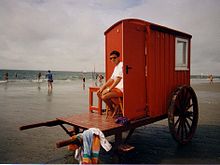Bath cart
A bath cart or bath cart was a wooden changing room on two or four wheels that was pulled into the water. In the 18th and 19th centuries, it offered women in particular the opportunity to bathe in the open sea in a morally correct and unseen way. At that time it was considered improper and offensive for women to bathe in sight of men, even if the swimwear customary at the time covered much more than it does today.
history
According to historical sources, the bathing cart was invented around 1750 by the Englishman Benjamin Beale in Kent (England). However, there is already a depiction in the Scarborough Public Library from 1736 by John Setterington showing such a vehicle. From England the bathing carts spread to the other European seaside resorts. In Germany they first appeared on Norderney and Travemünde around 1800 . After 1850, more and more bathing establishments and bathing stalls were built on the German coasts - initially separated by gender - so that the carts were rarely used. In Great Britain, legal gender segregation in bathing ended in 1901.
use

The bathing cart was initially on the beach and was entered by the users in street clothes, whereby a cart was always intended only for women or only for men. Inside the windowless cabin, the bathers changed their clothes, protected from prying eyes. There were benches that could seat four to six people. The cart was then pulled into the deeper water by a horse and carriage driver. In some English seaside resorts, however, wooden tracks were built into the water, and there were even constructions that used steam engines and wire rope winches.

From the back door, facing away from the beach, a small staircase led into the sea, over which a tarpaulin was stretched. A rope attached to the cart served as a tether for non-swimmers. At that time, most of the better society women could not swim, they only bathed. During the bath, the cart served as a privacy screen. Then it went back to the beach the same way.
In an article in the Mecklenburger Tageblatt from August 25, 1929, a contemporary witness recalled: "The bathing carts are spacious and comfortably furnished, are pulled by a horse into the appropriate water depth, and when they are bathed (which is indicated by the opening of the bathing umbrella), brought out in the same way. Such a bath from the bath cart costs 5 silver groschen for a single person and 6 silver groschen for two together. Huts built on the beach serve to accommodate bathers until it is their turn to bathe. "
See also
literature
- Gerhard Eckert : When the bathing carts rolled: Baltic seaside resorts from Travemünde to Glücksburg. Pleasant and remarkable . Hamburg 1977
- Horst Prignitz: From bathing carts to beach chairs. On the history of bathing on the Baltic coast . Leipzig 1977

